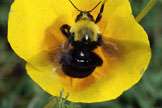Franklin's bumble bee may be extinct

(PhysOrg.com) -- Native pollinator specialist Robbin Thorp, emeritus professor of entomology at the University of California, Davis, just returned from a scientific trip to southern Oregon and Northern California to see if he could find the critically imperiled Franklin’s bumble bee.
No luck. He didn’t see a single one.
“But the season is still young,” he said, hopefully.
Each year since 1998, Thorp has conducted scientific surveys in the bumble bee’s narrow range of distribution. He annually makes three to five trips of several days each.
In 1998, he sighted 100 Franklin’s bumble bees (Bombus franklini). “It was relatively common then,” he said. “It was within the top 10 of the 20 or so species I was searching for.”
Thorp has seen it only once since 2004. “The last time I saw it was in August 2006 at Mt. Ashland when I spotted a single, solitary worker.”
Franklin’s bumble bee is a distinctive black-faced insect splashed with yellow markings on its thorax and top of its head. “It has a solid black abdomen and a black inverted U-shaped design on its yellow thorax.”
He fears that Franklin’s bumble bee may be extinct, and that other bumble bees are at risk of extinction.
Thorp, a fellow of the California Academy of Sciences since 1986, will discuss “The Plight of the Bumble Bee” from 12:10 to 1 p.m. at on Wednesday, May 27 in 122 Briggs Hall, UC Davis. The talk will be Webcast live in a pilot project spearheaded by UC Davis entomology professor James Carey, chair of the University of California Committee on Research Policy. Interested persons can sign up to view the Webinar at breeze.ucdavis.edu/ucsnbugs/ . The presentation also will be archived at entomology.ucdavis.edu/news/webcastlinks.html .
The decline, disappearance and possible demise of Franklin’s bumble bee, is closely linked to the widespread decline of native pollinators in North America, Thorp said, and should concern all facets of society. “The loss of a native pollinator could strike a devastating blow to the ecosystem, economy and food supply.”
“One of the main reasons the Franklin’s bumble bee is at risk is because it has such a small geographical range. It has the most restricted distribution range of any bumble bee in North America and possibly the world. Its range is about 190 miles north to south and 70 miles east to west in a narrow stretch between southern Oregon and northern California between the coast and Sierra-Cascade ranges.”
Its known distribution includes Jackson, Douglas and Josephine counties in Oregon and Siskiyou and Trinity counties in California. It lives at elevations ranging from 540 feet in the north to 6800 feet in the south.
Franklin’s bumble bee, named in 1921 for Henry J. Franklin, who monographed the bumble bees of North and South America in 1912-13, frequents California poppies, lupines, vetch, wild roses, blackberries, clover, sweet peas, horsemint and mountain penny royal during its flight season, from mid-May through September. It collects pollen primarily from lupines and poppies and gathers nectar mainly from mints.
It’s not just Franklin’s bumble bee that’s at risk, Thorp said. Populations of the Western bumble bee (Bombus occidentalis) and two close relatives in the east, the Rusty-patched bumble bee (B. affinis) and the Yellow-banded bumble bee (B. terricola) are rapidly dwindling, too, he said.
Bumble bees, commercially reared to pollinate greenhouse tomatoes, peppers and strawberries, pollinate about 15 percent of our food crops, valued at $3 billion, he said. Wildlife, including birds, elk, deer and bears depend on pollination of fruits, nuts and berries for their survival.
“We’re disturbing, destroying and altering the habitat where the native pollinators exist,” Thorp said.
Provided by University of California

















